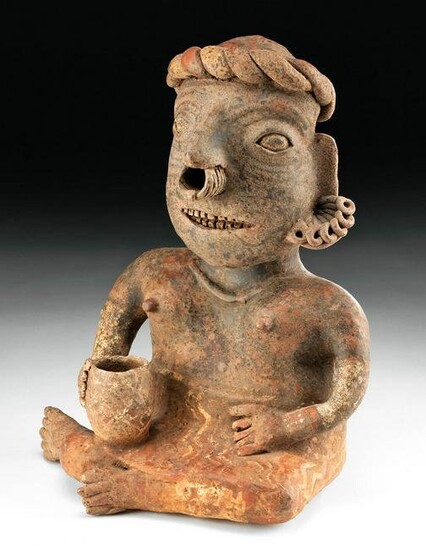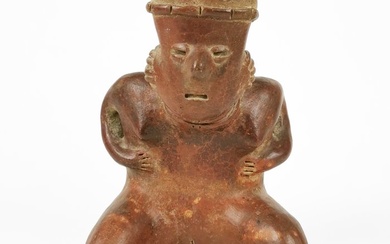Nayarit Seated Female in Trance, ex-Schmitt
**Originally Listed At $1000**
Pre-Columbian, West Mexico, Nayarit, Ixtlan del Rio type, ca. 300 BCE to 300 CE. A mesmerizing pottery figure of a seated female grasping a vessel and gazing forward with crazed eyes and gritted teeth; all suggesting she has just ingested a sacred hallucinogen as her spiritual journey commences. Though she exhibits typical Nayarit characteristics of a sizable head, flattened body, and tubular limbs, her huge nasal and ear ornaments as well as her twisted diadem imbue her appearance with a sense of nobility and high status, indicating she may be a shaman or priestess. Hypnotic designs of tattoos or body paint envelop her form, meandering across her voluptuous breasts and flat stomach and accentuating the psychedelic nature of the piece, as if she has brought the viewer visually along for the ride… Size: 8.5" W x 12.6" H (21.6 cm x 32 cm)
West Mexican shaft tomb figures like this one derive their names from the central architectural feature that we know of from this culture. These people would build generally rectangular vertical shafts down from the ground level down to narrow horizontal tunnels that led to one or more vaulted or rounded burial chambers. The geomorphology in the area means that these chambers are dug out of tepetate, a type of volcanic tuff material, which give the chambers a rough-edged look. Although the dimensions of the chambers vary considerably - some only large enough to hold a single burial and its offerings, others seem designed to hold entire lineages - the placement of burial goods like this hollow figure was very similar. Grouped with other hollow figures, and alongside clay bowls, and boxes, they were positioned around the body (or bodies), near the skull. Unfortunately, we lack the information we would need to understand what these figures were made for - do they represent everyday people, even individuals? Are they religious? Were they created to mediate between the living and the dead? Whatever their purpose, today they are beautiful artwork and reminders of the mysterious past.
Provenance: ex-Marc Amiguet Schmitt estate, Amiguet's Ancient Art, Evansville, Indiana, USA, acquired prior to January 1, 2010
All items legal to buy/sell under U.S. Statute covering cultural patrimony Code 2600, CHAPTER 14, and are guaranteed to be as described or your money back.
A Certificate of Authenticity will accompany all winning bids.
We ship worldwide to most countries and handle all shipping in-house for your convenience.
#174906
Condition Report: Losses to right ear and ear ornament. Light surface wear as shown. Otherwise, impressively preserved and in excellent condition with ample remains of pigments and rich earthen and manganese deposits throughout.
View it on
Estimate
Time, Location
Auction House
**Originally Listed At $1000**
Pre-Columbian, West Mexico, Nayarit, Ixtlan del Rio type, ca. 300 BCE to 300 CE. A mesmerizing pottery figure of a seated female grasping a vessel and gazing forward with crazed eyes and gritted teeth; all suggesting she has just ingested a sacred hallucinogen as her spiritual journey commences. Though she exhibits typical Nayarit characteristics of a sizable head, flattened body, and tubular limbs, her huge nasal and ear ornaments as well as her twisted diadem imbue her appearance with a sense of nobility and high status, indicating she may be a shaman or priestess. Hypnotic designs of tattoos or body paint envelop her form, meandering across her voluptuous breasts and flat stomach and accentuating the psychedelic nature of the piece, as if she has brought the viewer visually along for the ride… Size: 8.5" W x 12.6" H (21.6 cm x 32 cm)
West Mexican shaft tomb figures like this one derive their names from the central architectural feature that we know of from this culture. These people would build generally rectangular vertical shafts down from the ground level down to narrow horizontal tunnels that led to one or more vaulted or rounded burial chambers. The geomorphology in the area means that these chambers are dug out of tepetate, a type of volcanic tuff material, which give the chambers a rough-edged look. Although the dimensions of the chambers vary considerably - some only large enough to hold a single burial and its offerings, others seem designed to hold entire lineages - the placement of burial goods like this hollow figure was very similar. Grouped with other hollow figures, and alongside clay bowls, and boxes, they were positioned around the body (or bodies), near the skull. Unfortunately, we lack the information we would need to understand what these figures were made for - do they represent everyday people, even individuals? Are they religious? Were they created to mediate between the living and the dead? Whatever their purpose, today they are beautiful artwork and reminders of the mysterious past.
Provenance: ex-Marc Amiguet Schmitt estate, Amiguet's Ancient Art, Evansville, Indiana, USA, acquired prior to January 1, 2010
All items legal to buy/sell under U.S. Statute covering cultural patrimony Code 2600, CHAPTER 14, and are guaranteed to be as described or your money back.
A Certificate of Authenticity will accompany all winning bids.
We ship worldwide to most countries and handle all shipping in-house for your convenience.
#174906
Condition Report: Losses to right ear and ear ornament. Light surface wear as shown. Otherwise, impressively preserved and in excellent condition with ample remains of pigments and rich earthen and manganese deposits throughout.




